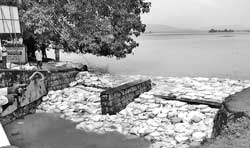
|
High and dry Hambantota now under water People blame officials for poor maintenance of wewas
People living in the Hambantota district have been known to suffer from severe droughts which often prompt people living in the rest of the country to dispatch donations to the victims, but when on rare occasions heavy rains are experienced they have to face floods. The Government appears to have failed to address this issue in the Hambantota district where the majority of the people depend on cultivation, despite several big projects proposed under the Mahinda Chinthana programme including the Weerawila international airport and the Hambantota harbour. People complain that irrigation tanks providing water for cultivation have not been renovated for many years with many of them silted reducing their storage capacity while bunds and banks of tanks are also in poor condition. Yodhawewa, Lunugamvehera, Tissawewa and Weerawila wewa are among the main tanks that stock water for irrigation and other purposes. However most of these tanks are filled with silt which has not been removed for several years. Hambantota District Secretary M.A. Piyasena said tanks in Hambantota need renovation to increase their storage capacity and admitted that Yodhawewa and Weerawila wewa especially were silted and should be dredged. He said presently an assessment is being carried out on the main tanks in the Hambantota district. Appropriate measures would be taken on the results of the assessment, he said. Floods in Hambantota displaced more than 2400 families in Magama, Yodhakandiya, Andaragasyaya and Kirinde in the Tissamaharama divisional secretariat area and in part of the Hambantota divisional secretariat area. Displaced people have been sheltered Yodhakandiya Devananda Vidyalaya, Kirinda Muslim School, Kirindagama Sinhala School Andaragasyaya fisheries community centre and Sarvodaya community centre in the Hambantota district. Mr. Piyasena said most of the people who were living in temporary shelters are moving to their houses and it is planned to set up two separate camps for people whose houses were completely destroyed by the heavy rains. He said this underdeveloped district has attracted several new State and as well as private projects, other than the proposed Weerawila international airport and the Hambantota harbour. An oil refinery, an international sports complex in Hambantota, international conference centre in Siribopura, a bio-diesel plant in Kurudana and the setting up of a botanical garden in Mirijjawila are among the projects that have been proposed for the development of Hambantota. According to figures, approximately 2,500 acres of paddy cultivation, 300 acres of vegetable and several acres of chena cultivation have been destroyed by the floods in addition to 52 houses. P. Hemaratne, a farmer in Tissamaharama said he lost his 10-acre paddy cultivation in 2001 because of the severe drought which affected the area and again this year he faced a similar disaster due to floods. He said the Government should take appropriate action to renovate tanks and dredge them so that more water can be stored in them and used when there is no rain. “Our ancestors have said that even a drop of water that comes down from the sky should be wasted but what has happened today is that all the rain water is washed into the sea as tanks are not capable of storing them”, he said. He said the last time the district suffered a flood was in 1997 but it was not so severe. W. Wijesinghe, a paddy farmer from Welipanewela, who was seeking temporary shelter in the Yodhakandiya Devananda Vidyalaya, said drought and rain equally affect farmers and added it was the responsibility of the Government to maintain a good irrigation system in the district so that farmers would be less affected during droughts as well as floods. “Rain water, if properly managed, can be used for cultivation for a few years. Unfortunately, the rain water is going into the sea”, he said. The farmer said cultivation could be carried out properly only during the Maha season as there was insufficient water to cultivate during other times. He said sand bags had to be piled close to banks and bunds of tanks to prevent them spilling over, and added it would have been a major disaster if the Yodhakandiya bund was fully breached. |
|| Front
Page | News | Editorial | Columns | Sports | Plus | Financial
Times | International | Mirror | TV
Times | Funday
Times || |
| |
Copyright
2006 Wijeya
Newspapers Ltd.Colombo. Sri Lanka. |
